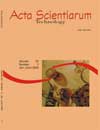<b>Percentual composition, fatty acids and quantification of the LNA (Alfa-Linolenic), EPA (Eicosapentaenoic) and DHA (Docosahexaenoic) acids in visceras of Nile Tilapia (<em>Oreochromis niloticus</em>)</b> - DOI: 10.4025/actascitechnol.v27i1.1501
DOI:
https://doi.org/10.4025/actascitechnol.v27i1.1501Keywords:
ácidos graxos, DHA, EPA, LNA, tilápias, víscerasAbstract
The chemical composition was evaluated in visceras of tilapias raised in captivity. The moisture, ash, crude protein and total lipids contents were 64.4%; 1.3%; 6.3% and 18.0%, respectively, characterizing high total lipids concentration in relation other residues of fish. Forty nine fatty acids were detected, the major fatty acids were oleic (32.8%), palmitic (19.9%) and linoleic-1 (18.2%) and oleic (9.4%). The ratio n-6/n-3 and polyunsaturated/saturated fatty acids, showed the values 5.5 and 0.9, respectively. The quantifications of alfa-linolenic, eicosapentaenoic and docosahexaenoic acids (in mg/g of total lipids), were 10.4, 1.4 and 0.3, respectively. The higher contents of total lipids in visceras contributed significantly for amounts of n-3 fatty acids. All the parameters analyzed were shown nutritional value satisfactory in this sense visceras of tilapias can be used in the feed of fish and other animal.Downloads
Download data is not yet available.
Downloads
Published
2008-03-27
How to Cite
Souza, N. E. de, Matsushita, M., Franco, M. R. B., Prado, I. N. do, & Visentainer, J. V. (2008). <b>Percentual composition, fatty acids and quantification of the LNA (Alfa-Linolenic), EPA (Eicosapentaenoic) and DHA (Docosahexaenoic) acids in visceras of Nile Tilapia (<em>Oreochromis niloticus</em>)</b> - DOI: 10.4025/actascitechnol.v27i1.1501. Acta Scientiarum. Technology, 27(1), 73–76. https://doi.org/10.4025/actascitechnol.v27i1.1501
Issue
Section
Chemistry
License
DECLARATION OF ORIGINALITY AND COPYRIGHTS
I Declare that current article is original and has not been submitted for publication, in part or in whole, to any other national or international journal.
The copyrights belong exclusively to the authors. Published content is licensed under Creative Commons Attribution 4.0 (CC BY 4.0) guidelines, which allows sharing (copy and distribution of the material in any medium or format) and adaptation (remix, transform, and build upon the material) for any purpose, even commercially, under the terms of attribution.
Read this link for further information on how to use CC BY 4.0 properly.















8.png)




